In the realm of makeup artistry, contouring has emerged as a powerful technique to enhance facial features and achieve a sculpted, well-defined look. Best Contour makeup involves using darker and lighter shades to create shadows and highlights, respectively, thereby altering the appearance of facial structure.
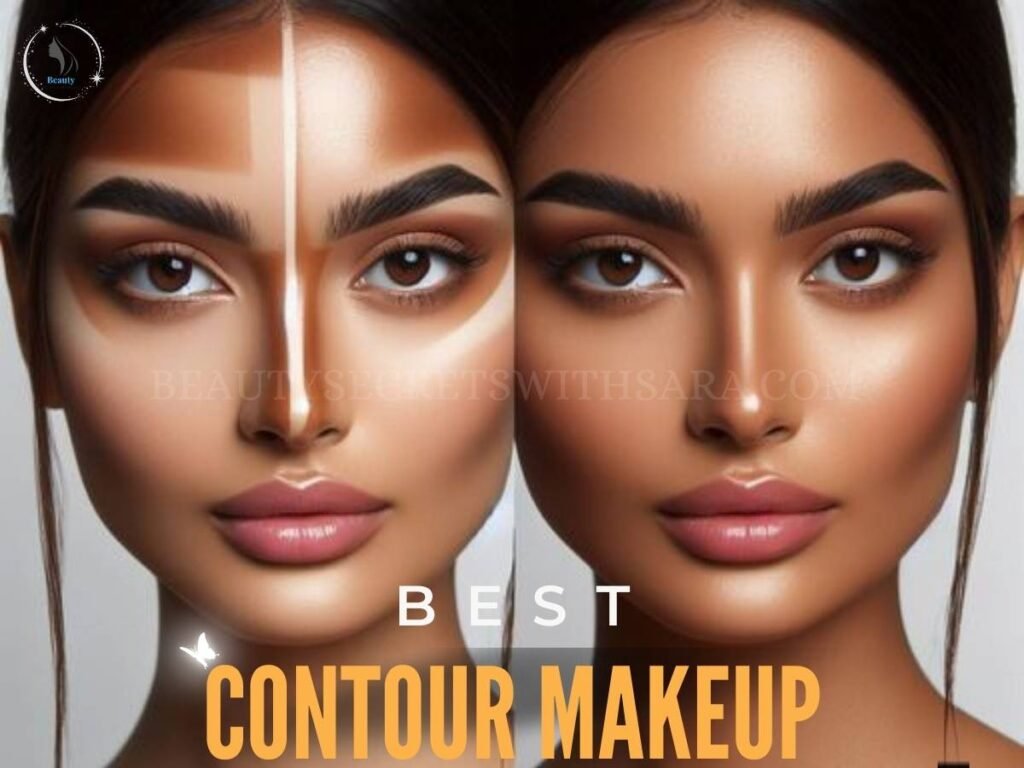
Image in Canva Pro
Contour makeup has revolutionized the beauty industry, offering individuals the ability to sculpt and define their facial features with precision. Whether you’re aiming for a subtle enhancement or a dramatic transformation, mastering the art of contouring can elevate your makeup game to new heights. In this comprehensive guide, we’ll delve into everything you need to know about achieving the best contour makeup looks.
Contour makeup involves the strategic use of darker and lighter shades to create dimension and structure on the face. By shading and highlighting specific areas, contouring can alter the appearance of facial features, providing definition and symmetry. From sculpting cheekbones to slimming the nose, the possibilities are endless with contour makeup.
In This Article
What is Best Contour Makeup?
Contour makeup refers to the application of makeup products, typically in cream, powder, or stick form, to create the illusion of enhanced cheekbones, a slimmer nose, a more defined jawline, and other desired facial features.
Types of Contour Products
Contour products come in various formulations to suit different preferences and skin types.
- Cream contours offer bendability and hydration
- Powder contours provide a matte finish ideal for oily skin.
- Stick contours offer convenience and precision
Making them a popular choice for on-the-go touch-ups.
Why is Contouring Important in Makeup?
Contouring allows individuals to sculpt their faces, emphasizing their best features while minimizing others. It’s a transformative technique that can create the appearance of higher cheekbones, a more chiseled jawline, and a slimmer nose, among other benefits.
How to Choose the Right Shade
Selecting the correct contour shade is essential for achieving a natural-looking result. Understanding your skin’s undertones—whether warm, cool, or neutral—is crucial for finding a shade that complements your complexion. Testing shades on your jawline can help ensure a seamless match.
Tools for Contouring
The right tools can make all the difference in achieving a flawless contour. Brushes with angled or tapered bristles are ideal for precise application, while beauty blenders offer seamless blending for a natural finish.
Best Contour Makeup for Beginners
Contour makeup has become a staple in the beauty routines of many, but for beginners, it can be intimidating to know where to start. With the right products and techniques, anyone can achieve a flawless contoured look that enhances their natural features.
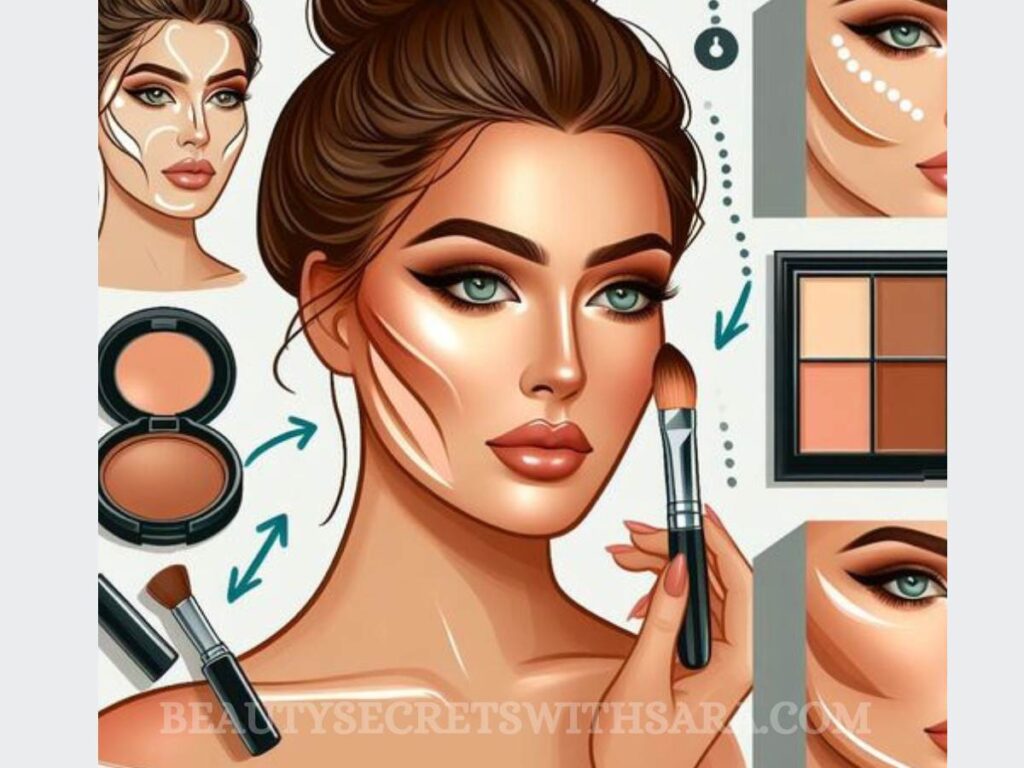
Image in Canva Pro
Contour makeup consists of using darker shades to create shadows and lighter shades to highlight areas of the face. By strategically applying these products, you can alter the appearance of your facial structure, achieving a more sculpted look.
Choosing the Right Contour Makeup Products
Cream vs. Powder Contour
When it comes to contour makeup, there are two main types of products: cream and powder. Cream contour products are ideal for beginners as they are easier to blend and build up gradually. Powder contours, on the other hand, are great for oily skin types and offer a more natural finish.
Shades for Different Skin Tones
It’s crucial to choose contour shades that complement your skin tone. For fair skin, opt for cooler-toned contours, while warmer tones work well for medium to deep skin tones. Avoid shades that are too dark or orange, as they can appear unnatural on the skin.
Step-by-Step Guide to Contouring for Beginners
Prepping the Skin
Start by prepping your skin with a moisturizer and primer to create a smooth base for makeup application. Allow the products to absorb fully before moving on to contouring.
Mapping Out the Contour
Using a cream or powder contour product that is one to two shades darker than your natural skin tone, begin by mapping out the areas you want to contour. Focus on the hollows of the cheeks, along the jawline, and the sides of the nose.
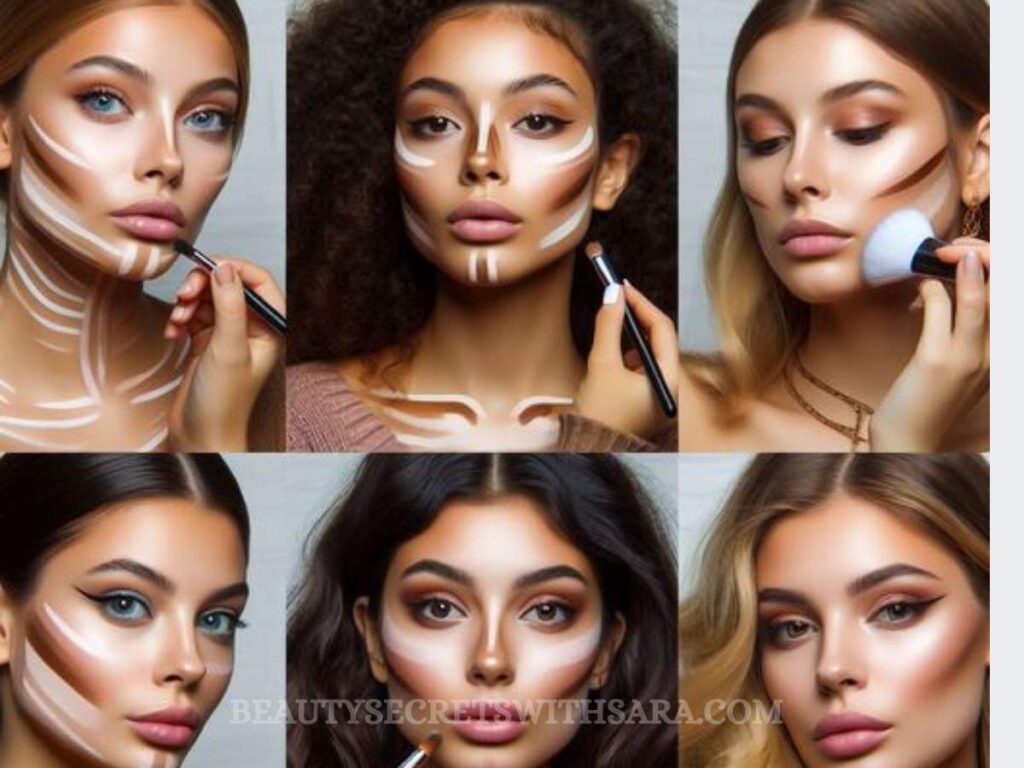
Image in Canva Pro
Blending Techniques
Blend the contour product using gentle tapping and sweeping motions to avoid harsh lines. Focus on blending upwards and outwards for a lifted effect. Take your time with blending to ensure a seamless finish.
Common Mistakes to Avoid
Over contouring
One of the most common mistakes beginners make is applying too much contour product. Start with a small amount and build up gradually to avoid a heavy, unnatural look.
Choosing the wrong shades
Another common mistake is choosing contour shades that are too dark or warm for your skin tone. Always test shades before purchasing and opt for colors that mimic natural shadows.
Pro Tips: Blend, blend, blend! Seamless blending is key to achieving a natural-looking contour.
Best Contour Makeup for Mature Skin
Contour makeup involves using darker and lighter shades to enhance and define facial features, creating dimension and symmetry. For mature skin, which may experience loss of elasticity and firmness, contouring can help redefine features and impart a more youthful appearance. It’s not about drastically altering one’s appearance but rather subtly enhancing natural contours.
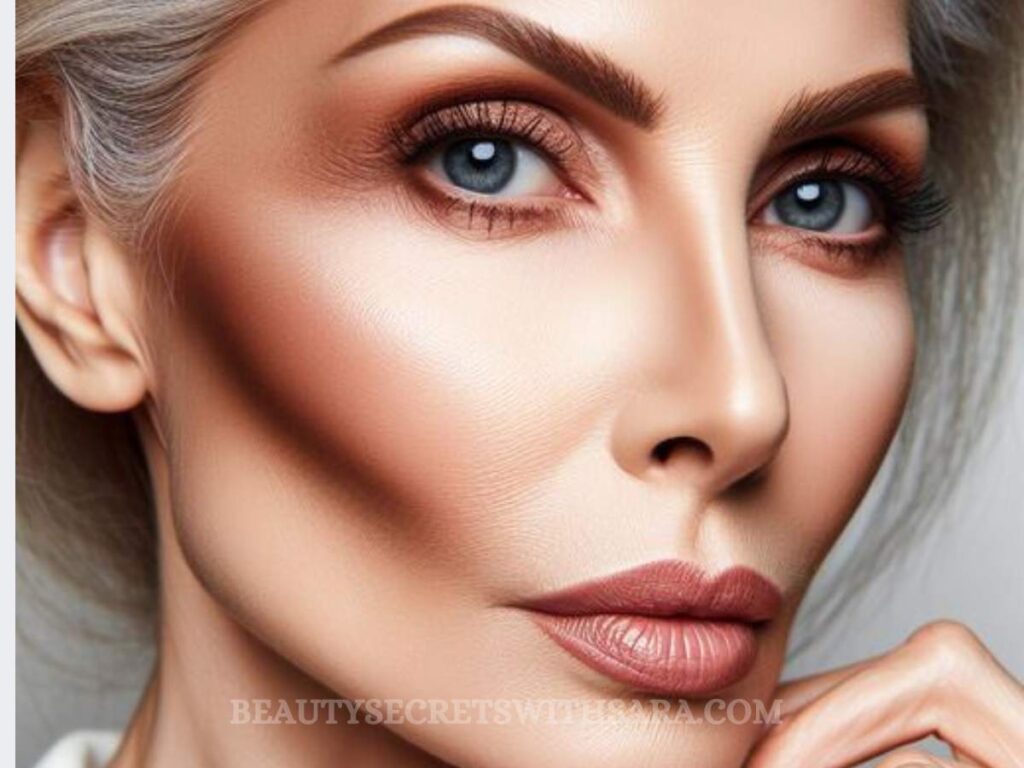
Image in Canva Pro
Choosing the Right Contour Products
When selecting contour products for mature skin, opt for cream formulations over powders. Cream contours blend seamlessly into the skin, providing a more natural finish and avoiding any emphasis on fine lines or wrinkles. Look for products enriched with hydrating ingredients like hyaluronic acid and vitamin E to nourish the skin while adding definition.
Preparing the Skin
Before applying contour makeup, ensure your skin is well-prepped and hydrated. Follow a skincare routine tailored to mature skin, including moisturizing and using serums to plump and firm the skin.
Application Techniques
When applying contour makeup less is more. Start with a light hand and build up the product gradually to avoid a heavy or cakey appearance. Use a damp makeup sponge or a fluffy brush to blend the product seamlessly into the skin, focusing on areas where you want to add definition, such as the hollows of the cheeks, jawline, and temples.
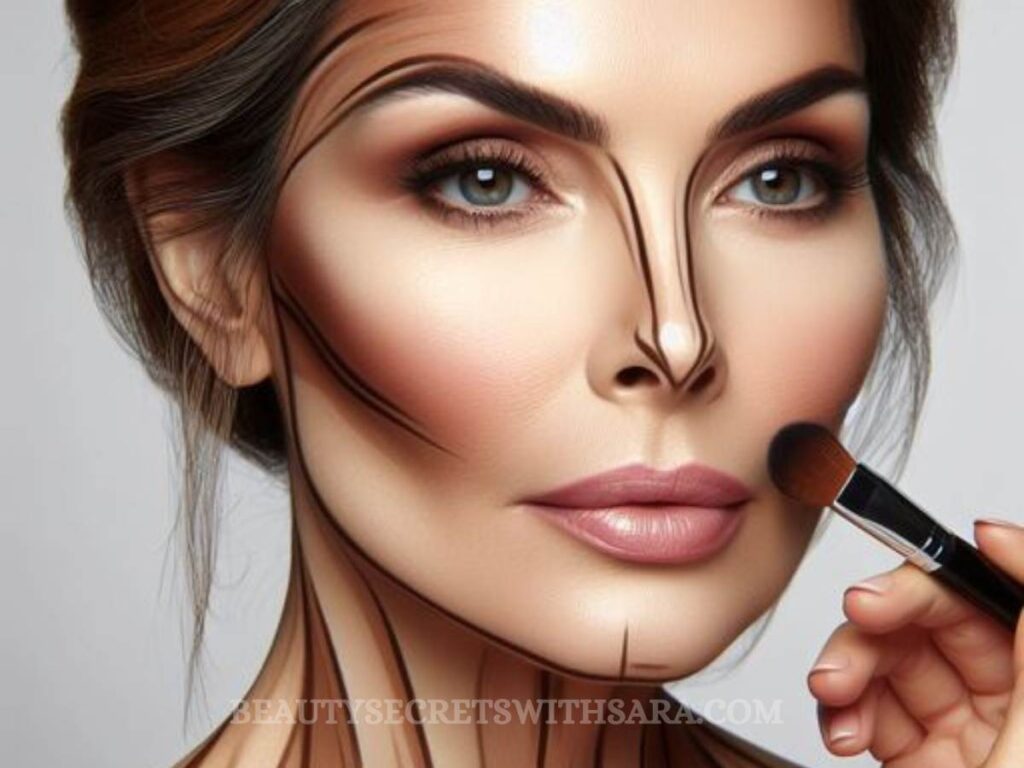
Image in Canva Pro
Areas to Contour and Highlight
Focus on enhancing your natural features rather than drastically altering them. Contour the hollows of the cheeks to add definition, sculpt the jawline to create a more lifted appearance, and subtly contour the nose to refine its shape. When highlighting, use a lightweight, luminous formula to accentuate the high points of the face, such as the cheekbones, brow bones, and cupid’s bow.
Pro Tips: Focus on lightly dusting the T-zone and areas prone to oiliness while avoiding over-powdering the rest of the face to maintain a natural radiance. Carry a compact powder or setting spray for quick touch-ups, especially in warmer weather or humid conditions.
Best Contour Makeup for Skin Types
The world of contour makeup tailored for different skin types and concerns.
i) Oily Skin
Dealing with oily skin can present its own set of challenges when it comes to makeup application. The key is to find contour products that are oil-free and non-comedogenic to prevent clogged pores and unwanted shine. Opt for matte contour powders or creams that can help absorb excess oil while providing long-lasting definition.
When applying contour on oily skin, blend thoroughly and set with a translucent powder to ensure a matte finish that stays put throughout the day.
ii) Fair or Pale Skin
Fair or pale skin tones often require extra care when selecting contour shades to avoid looking too harsh or muddy. Look for contour products with cool undertones that mimic natural shadows without appearing too stark against fair skin.
Soft taupe or ash brown shades work well for creating subtle definition without overwhelming lighter complexions. Blend with a light hand and build up gradually for a seamlessly sculpted look that complements fair skin beautifully.
iii) Dry Skin
Dry skin can benefit from contour products that offer hydration and luminosity to prevent makeup from looking dull or clinging to dry patches. Opt for creamy contour sticks or hydrating powder formulas enriched with nourishing ingredients like hyaluronic acid or vitamin E.
Prioritize skincare by moisturizing thoroughly before applying contour makeup to ensure a smooth and radiant base. Avoid heavy powders that can accentuate dryness, and focus on lightweight, buildable formulas for a natural-looking contour on dry skin.
iv) Sensitive Skin
Sensitive skin requires extra gentle care when it comes to makeup application to avoid irritation or allergic reactions. Look for contour products that are fragrance-free, hypoallergenic, and formulated with soothing ingredients such as chamomile or aloe vera.
Stick to cream or gel-based contours that blend easily without tugging or pulling on the skin. Always patch test new products and opt for minimal ingredients to reduce the risk of sensitivity issues.
v) Asian Skin
Asian skin comes in a diverse range of tones and undertones, requiring contour products that cater to specific needs. Warm, golden undertones are common in Asian skin, making bronzy contour shades an excellent choice for adding warmth and dimension. Avoid overly cool or ashy tones that can appear unnatural on Asian skin tones.
Focus on softly sculpting the features with a light hand and blending seamlessly for a natural, sculpted look that enhances Asian beauty.
vi) Black Skin
Black skin is rich in melanin and often requires contour products with deep pigmentation and rich undertones to complement its natural beauty. Look for contour shades with warm, reddish undertones that mimic natural shadows on black skin tones.
Deep chocolate browns and mahogany hues work beautifully for sculpting and defining facial features without appearing too harsh or muddy. Embrace the versatility of black skin by experimenting with different contouring techniques to enhance its unique characteristics.
Finding the best contour makeup for your specific skin concern is essential for achieving a flawless and natural-looking sculpted look. Whether you have oily, fair, dry, sensitive, Asian, or black skin, there are contour products available to cater to your needs.
Contour Makeup Trends
The field of contour makeup is always expanding, with new techniques and trends emerging on a regular basis. From non-touring to draping, staying up-to-date with the latest trends can inspire you to try new looks and techniques for a fresh, modern approach to contouring.
Key Conclusion
- Contour makeup is a powerful tool for enhancing your natural beauty and expressing your creativity through makeup.
- By understanding the principles of contouring, experimenting with different products and techniques, and embracing your unique features, you can achieve stunning contour makeup looks that leave a lasting impression.
FAQs
Q1. Is contour makeup suitable for everyday wear?
While contour makeup can create dramatic effects, it can also be used subtly for everyday looks. Opt for lighter application and natural shades for a more casual appearance.
Q2. Can contouring make my face look thinner?
Yes, contouring is designed to create the illusion of a slimmer face by strategically placing shadows and highlights. With proper technique, you can sculpt your features to achieve a more defined look.
Q3. What is the difference between bronzing and contouring?
Bronzing adds warmth and dimension to the face, typically using a warm-toned powder or cream product. Contouring, on the other hand, focuses on creating shadows and highlights to alter the shape of the face.
Q4. Can contour makeup cause breakouts?
Contour makeup products are generally safe for use, but individuals with sensitive or acne-prone skin should opt for non-comedogenic formulas to reduce the risk of breakouts.
Q5. How can I blend contour makeup seamlessly?
Use a clean makeup sponge or brush to blend contour products into the skin for a seamless finish. Light tapping and swirling motions help blend the product evenly without harsh lines.
Q6. How do I choose the right contour shade for my skin tone?
Look for contour shades that are one to two shades darker than your natural skin tone and have undertones that complement your complexion.
Q7. Can I use contour makeup if I have oily skin?
Absolutely! Opt for powder contour formulas that can help control excess oil and shine throughout the day.
Q8. What’s the difference between bronzer and contour makeup?
While both products can add warmth and dimension to the face, bronzer is typically used to mimic a sun-kissed glow, while contour makeup is used to create shadows and define facial features.
Q9. How can I prevent my contour makeup from looking muddy or streaky?
Ensure you blend thoroughly using a clean brush or sponge, and start with a light hand, building up the product gradually to avoid harsh lines.

